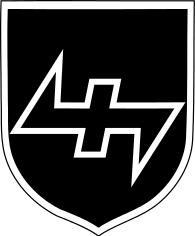34th SS Volunteer Grenadier Division Landstorm Nederland
| 34th SS Volunteer Grenadier Division Landstorm Nederland | |
|---|---|
|
Insignia of the 34th SS Volunteer Grenadier Division Landstorm Nederland | |
| Active | 12 March 1943 - 5 May 1945 |
| Country |
|
| Branch |
|
| Type | Infantry |
| Size | Division |
| Engagements | World War II |
| Commanders | |
| Notable commanders | Martin Kohlroser |
The 34th SS Volunteer Grenadier Division Landstorm Nederland was a Division during World War II which wasn't officially an SS unit, although it was subjected to Waffen-SS laws and jurisdiction of the SS-und Polizeigericht.[1] It was formed by the converting of the SS Volunteer Grenadier-Brigade Landstorm Nederland into a division. It comprised volunteers of Dutch background and saw action on the Western Front, but its strength never reached more than a brigade.
Formation
Nederland was the second Dutch formation to be raised, following the 4th SS Volunteer Panzergrenadier Brigade Nederland. The recruits were drawn mostly from the Nationaal-Socialistische Beweging (the Dutch Nazi Party). 130 Dutch personnel were transferred from the SS Division Wiking and 11th SS Volunteer Panzergrenadier Division Nordland. While some of them were assigned as NCOs for the new unit, it was officered by German SS men, and no Dutchman was ever promoted to a higher rank than company commander. The division's insignia featured the Wolfsangel rune. Numbering 2,400 men on 16 October 1943, the regiment received its designation as SS-Grenadier-Regiment 1 Landstorm Nederland.
Battles in Belgium and the Netherlands
After the Allied breakout from Normandy, Field Marshal Bernard Montgomery's 21st Army Group began its advance along the Channel Coast towards Germany. In early September, two battalions of the Landstorm were rushed to the front in Belgium. The formation was tasked with defending the Albert Canal around the areas of Merksem and Hasselt. Inadequately armed and with minimal combat experience, the two battalions fared poorly during a battle with the Free-Dutch Princess Irene Brigade and was forced to withdraw.
On 17 September, Montgomery launched Operation Market Garden an offensive pioneered with airborne forces aimed at securing a crossing over the Rhine at Arnhem, in the central-eastern part of the Netherlands. The Landstorm's III. Battalion was completing its training near Hoogeveen. The partially trained and equipped formation was attached to the 9th SS Panzer Division Hohenstaufen and sent into combat against the British 1st Airborne Division in Arnhem. Having little faith in the Dutch volunteers' combat ability, the Hohenstaufen's commander held them back from action for as long as possible. On 21 September, the III./Landstorm was committed to action near the town of Elst on the Arnhem-Nijmegen highway (in the Eastern part of the Betuwe, then known as "Manneneiland" ("men's island") due to it being enclosed by large rivers and all civilians evacuated). After holding the town for several days, the Landstorm was pushed back by the British 43rd (Wessex) Division. The battalion was pulled out of the line on 25 September.
Final Battles
On 1 November, the Landstorm was redesignated SS Volunteer Grenadier Brigade Landstorm Nederland, with existing battalions redesignated as regiments. After a brief period of refitting, the Landstorm was ordered to take up defensive positions near the Waal and Rhine rivers.
On 10 February 1945, the Landstorm again had its status raised and was redesignated 34th SS Volunteer Grenadier Division Landstorm Nederland, while still being a weak brigade. The division was immediately ordered to relieve Fallschirmjäger-Regiment 7, at that time defending the Rhine, in the area between Betuwe and Rhenen. Much of the area had been flooded to assist the overstretched German forces in their defense. Facing the division was the Princess Irene Brigade, the British 49th (West Riding) Infantry Division and several Canadian formations.
The unit suffered low morale and desertions. Several men were court-martialed and shot for plotting to assassinate officers. As the war drew to a close, attacks on the civilian population by the division increased, and the men of the 84th SS Volunteer Grenadier Regiment in particular were involved in several atrocities. Forced back to the area near Oosterbeek, the remnants of the division surrendered on 5 May 1945.
A small unit held out in the village of Veenendaal, engaging in combat with the Binnenlandse Strijdkrachten until surrendering on 9 May to the 49th (West Riding) Division. As collaborators, the majority of the survivors were imprisoned, and several were summarily executed.
Commanders
- SS-Oberführer Viktor Knapp (11 May 1943 - 1 April 1944)
- SS-Obersturmbannführer Deurheit (1 April 1944 - 5 November 1944)
- SS-Standartenführer Martin Kohlroser (5 November 1944 - 8 May 1945)
Orders of Battle
- Division HQ
- SS-Feldersatz-Battalion 60
- Grenadier-Regiment 1
- SS Volunteer Grenadier Regiment 83 (3rd Dutch)
- SS Volunteer Grenadier Regiment 84 (4th Dutch)
- SS Artillery Regiment 60
- SS Panzerjäger Battalion 60
- SS Pionier Company 60
- SS Signals Company 60
- SS Veterinary Company 60
- SS Field post Department 60
- SS Medical Company 60
References
- Pierik, Perry - From Leningrad to Berlin: Dutch Volunteers in the German Waffen-SS
- Viccx, Jan / Schotanius, Viktor - Nederlandse vrijwilligers in Europese krijgsdienst 1940-1945 (Vol 1: de Landstorm)
| ||||||||||||||||||||||||||||
| ||||||||||||||

